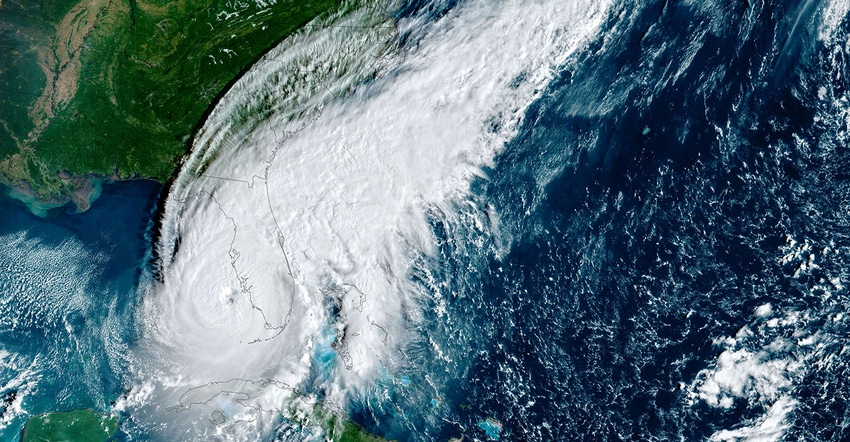Resin Price Report: Tropical Storm Ian Batters Florida but Spares Petrochemical Infrastructure
Resin trading has not felt much of an impact from the storm, with spot PE prices flat, while PP lost as much as $0.08/lb.
September 29, 2022

Hurricane season has come to life in what is typically a more active cycle in September/October, reports the PlasticsExchange in its Market Update.
At the time of writing, Tropical Storm Ian has wreaked havoc across much of central and northeastern Florida since hitting the mainland, but it has spared the Texas and Louisiana refining and petrochemical infrastructure. Nevertheless, it did have a small impact on oil production along along the western areas of the Gulf of Mexico, reports ICIS. Personnel were evacuated from 11 production platforms earlier in the week as a precautionary measure, and three rigs were moved out of the storm’s projected path, said the business intelligence company serving the chemicals and energy sectors.
Meanwhile at the PlasticsExchange, spot resin trading slowed a bit the week of Oct. 19, with completed volumes down from above-average levels seen earlier in the month, but still better than the anemic pace in August.
Processors buy resin on as-needed basis
Polyethylene (PE) offers slowed, while the number of polypropylene (PP) offers increased. Prime resin prices were mixed, as PE stayed flat amid further consolidation, while PP lopped off as much as $0.08/lb. PE producers have cut reactor rates as they continue to work down resin stockpiles that have kept warehouses packed for much of the year. By contrast, PP production still seems too high and inventories remain burdensome, writes the PlasticsExchange. Most processors typically are buying resin as needed, while some are starting to procure a little extra as the price level becomes advantageous, despite slowing downstream consumer demand amid economic and inflationary concerns.
More PE producers have doubled down on price increases as a protective measure against potential hurricane/production-related problems. September PE increases of $0.05/lb remain on the table, while more producers have joined the collective push for October increases of $0.05 to 0.07/lb.
Force majeure in Mexico
In Mexico, PE production is offline for one producer. In a letter to customers during the week, Pemex said the crackers and derivatives plants at its petrochemical facilities in Coatzacoalcos were out of operation following an explosion on Tuesday at an ethane pipeline. Pemex also produces PE at Coatzacoalcos and said it was awaiting an estimated date for the repair of the damaged pipeline and startup of crackers and derivatives plants, according to the PlasticsExchange. The company also said that a force majeure will be made by the corresponding areas.
PE remained the more dominant resin transacting across the PlasticsExchange platform. Prime prices held firm, while the low end of the market continued to rise. As previously reported, spot prices are eroding much faster than contracts, so contract decreases could still be easily justified.
Buyer interest was focused on Injection grades last week, with good demand for high-density, low-density, and linear-low-density PE against relatively scant spot supplies compared with film grades, which were still plentiful, and blow molding, which has started to tighten a tad.
Producers and other major resin suppliers continued to scoff at lowball bids, as the bearish tide has turned alongside lower operating rates and an uptick in Asian prices. This has spurred domestic demand, as some buyers expressed a fear of missing out on great deals, which are still in the realm of bargain basement prices. In the meantime, producers continue to pursue contract increases for September as well as October. However, the likelihood of a decline, at least for September, seems more feasible unless a major event like a hurricane disrupts production, according to the PlasticsExchange.
PP trading lacked luster, as weak demand continued for various reasons — a slowing global economy, near-term economic uncertainty, ongoing overproduction of resin, and buyers flexing their negotiating strength.
Homo- and co-polymer PP prices at lowest level since December 2020
Homo-polymer PP peeled off a nickel, and co-polymer PP dropped even further, by a full $0.08/lb. Prices are now at their lowest level since December 2020. The spread between both grades also dropped down to $0.07/lb from a dime, which had been in place since March (premiums typically contract in major down cycles). The spread between both grades is generally in the $0.02 to 0.04/lb range, and we could be moving back to the high side. Inventory offering lists and general PP availability increased — there was a heavier flow of off-grade resin, possibly a result of reduced operating rates, which affect consistency of Prime quality. On the other hand, some producers were soliciting blanket orders for Q4 at reduced premiums over polymer-grade propylene (PGP) monomer costs as they try to fill up reactor time. Given sluggish demand, this tactic would only lift orders from other producers and hamper overall industry margins.
PP contracts are estimated to settle down $0.08/lb cents for September, which would include a cost-related decrease as well as a reduction in margins. If producers continue to step in front of each other to gain orders via share shifting, rather than simply slowing production to rebalance supply/demand, we could see additional margin declines ahead, according to the PlasticsExchange.
Read the full Market Update, including news about PGP pricing and energy futures, on the PlasticsExchange website.
You May Also Like


